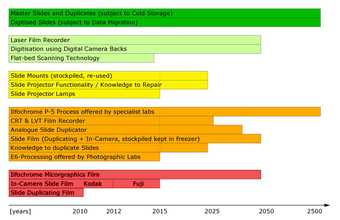The diagram below is a visualisation of the three factors affecting our ability to continue to show 35 mm slide-based artworks as slide projections and current options for digitisation and storage:
- can I purchase slide stock? (red)
- can I duplicate slides after slide stock has discontinued? (orange)
- are there slide projectors, spare parts and accessories available? (yellow)
- what technologies are available for digitisation? (light-green)
- what is the predicted longevity in storage? (green)

Expected decline of slide technology related services, each colour represents a different activity
Technological environments are like ecosystems with multiple dependencies. The constituent with the shortest life expectancy limits the availability of the associated activity. Whilst stockpiling slide film and slide projector lamps is recommended, it must be seen in the context of the other parts of the technological environment. For example, if a digital scan is available, this also enables the use of film recorders (LVT, CRT) to create slides from the digital scan onto slide stock as long as the E-6 developing process remains available.
I have tried to estimate the life expectancy of the significant components of the technological infrastructure upon which 35 mm slide-based artworks depend; predicting the future, however, is never an exact science.
A course of action which maximises options over time is prudent. In my opinion, based on the research carried out in this project, the best use of resources is to split the available budget between creating analogue duplicates, digitising the collection and locating projector parts. In our situation, analogue duplication remains a viable option given access to the generous amount of slide duplication film that Activity, the slide lab with whom Tate is collaborating, has stockpiled over recent years.
Different collections, however, will have different local circumstances which make different courses of action both feasible and recommended. For example, the Guggenheim in New York has digitised some of the slide works through a partnership with Albumen Works in Chicago, and they are achieving great results by creating duplicates via LVT recorders; whereas the Kunsthaus Zürich in Switzerland has been duplicating slides on microfilm, in close collaboration with Mikrosave.
The relationships one builds are essential to the success of any of these methods. Every method has its particular advantages and disadvantages and as long as conservators can rely on experts who have perfectly mastered the chosen technology, there is great value in this pluralism of approaches.
